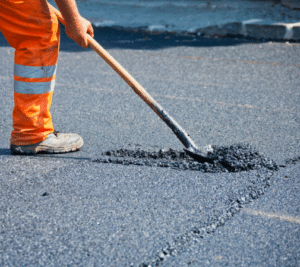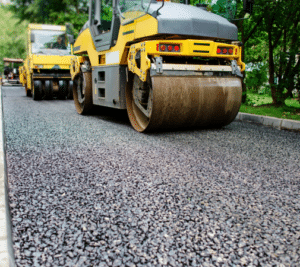Asphalt patching is used to repair existing asphalt surfaces that have become damaged due to wear and tear. This process involves filling the affected area with hot mix asphalt, which can be applied by hand or machine. Asphalt patching is often used to repair cracks, potholes, and other areas of deterioration on roads, parking lots, driveways, and other asphalt surfaces. Patching is a cost-effective and time-efficient way to extend the life of these surfaces.
Benefits of Asphalt Patching
Asphalt patching offers numerous benefits for both residential and commercial properties. Whether it’s a small crack or a large pothole, repairing damaged asphalt surfaces is essential to maintaining the integrity and appearance of your pavement. Here are some of the key benefits of asphalt patching:
1. Cost-effective solution: Asphalt patching is more cost-effective than completely resurfacing or replacing the entire pavement. By promptly addressing the damaged areas, you can prevent further deterioration and costly repairs.
2. Increased safety: Cracks, potholes, and other surface damage can create hazardous conditions for pedestrians and vehicles. Asphalt patching helps to eliminate these dangers, reducing the risk of accidents, injuries, and potential liability issues.
3. Protects the pavement’s structural integrity: By repairing damaged areas promptly, asphalt patching helps preserve the overall structural integrity of the pavement. This prevents water infiltration, which can weaken the base and potentially lead to more extensive damage.
4. Prevents further deterioration: Small cracks and potholes can quickly worsen if left untreated. By patching these damaged areas, you prevent moisture from penetrating the pavement, which can cause the cracks to expand and lead to more significant issues.
5. Improves the appearance: Cracked and damaged asphalt surfaces are unattractive and can negatively impact the overall aesthetics of your property. Asphalt patching helps restore the smooth, uniform pavement appearance, enhancing your property’s curb appeal.
6. Enhances property value: Well-maintained and visually appealing pavement adds value to your property. By investing in asphalt patching, you’re ensuring the safety and functionality of the pavement and increasing the value of your property.
7. Extends the pavement’s lifespan: Regular asphalt patching can significantly extend the lifespan of your pavement. By addressing minor damages promptly, you prevent them from progressing into more extensive issues that require costly repairs or replacement.
8. Minimizes business disruptions: Potholes and uneven surfaces can disrupt daily operations for commercial properties. By promptly patching these areas, you ensure a smooth and safe parking lot or driveway, minimizing disruptions to your business or inconvenience to your customers.
Asphalt patching is an effective and efficient way to repair damaged pavement and avoid costly repairs or replacements. By addressing minor issues before they escalate, you can save money, enhance safety, and maintain the overall aesthetics of your property. Consult with a professional asphalt contractor to assess your pavement and determine the most suitable patching solution for your needs.
Types of Asphalt Patching
Several techniques and materials can be used to repair damaged areas when it comes to asphalt patching. The type of patching method used will depend on the severity and extent of the damage, as well as other factors such as the climate, traffic load, and budget. Here are some common types of asphalt patching:
1. Spray Injection Patching: This method involves using specialized equipment to clean the damaged area with high-pressure air and then filling it with a mixture of asphalt emulsion and aggregate. The mixture is sprayed into the pothole or crack, creating a durable and long-lasting patch.
2. Throw-and-roll Patching: This is one of the most basic and standard asphalt patching methods. It involves simply placing and compacting hot mix asphalt into the damaged area using hand tools or equipment like a vibratory plate compactor. This method is suitable for more minor potholes and cracks.
3. Semi-permanent Patching: This method is similar to throw-and-roll patching but involves more extensive preparation. The damaged area is first excavated and cleaned, then a tack coat is applied to the edges. Hot mix asphalt is then placed and compacted using special equipment. This type of patching provides a more durable and long-lasting repair.
4. Full-depth Patching: Full-depth patching may be required if the damage extends to the base or sub-base of the pavement. This method removes the damaged area, including the underlying layers, and replaces it with new asphalt. The new patch is then compacted to ensure a strong and stable repair.
5. Infrared Patching: This innovative method uses infrared heat to soften the existing asphalt and mix it with new asphalt to create a seamless and durable patch. It is particularly effective for repairing wide cracks, alligator cracks, and other surface damage.
6. Cold Patching: Cold patching is a temporary solution for minor repairs, particularly in colder temperatures when hot mix asphalt is not readily available. Cold patch materials are premixed and can be applied directly to the damaged area without heating. However, it is important to note that cold patching is not as durable or long-lasting as hot mix asphalt patching.
Overall, the type of asphalt patching used will depend on factors such as the severity of the damage, the availability of equipment and materials, and the desired longevity of the repair. It is essential to consult with a professional asphalt contractor to determine the most appropriate patching method for your specific needs.
Preparing for an Asphalt Patch Job
Proper preparation is crucial to ensure a successful and long-lasting patch job when repairing damaged asphalt surfaces such as potholes, cracks, or worn-out areas. Whether you’re tackling a minor repair or a larger project, taking the time to prepare the area before applying asphalt will significantly enhance the effectiveness and durability of the patch. Here are some essential steps to consider when preparing for an asphalt patch job.
1. Assess the Damage: Begin by assessing the extent and nature of the damage. Identify the size, depth, and location of potholes or cracks. This will help you determine the appropriate patching technique and the required materials.
2. Clean the Area: Before applying any patching material, thoroughly clean the damaged area. Remove any loose debris, dirt, or vegetation. Additionally, use a high-pressure air blower or a broom to eliminate any loose or weak particles from the surface. A clean and debris-free area ensures better adhesion of the patching material.
3. Square the Edges: For a cleaner and more stable repair, square the edges of the damaged area. Using a cold chisel and hammer, create clean and smooth edges. This step helps increase the bond between the existing pavement and the new patching material.
4. Apply a Tack Coat: Applying a tack coat is recommended to enhance the bond between the existing pavement and the new patch. A tack coat is a thin layer of asphalt emulsion that acts as a bonding agent. It helps create a solid and secure bond between the patch material and the existing pavement. Use a brush or a spray wand to apply the tack coat to the edges and bottom of the prepared area.
5. The Patching Process: Choose an appropriate patching method depending on the size and type of damage. If it is a small pothole or crack, throw-and-roll patching or spray injection patching may be suitable. However, for more extensive damage, consider semi-permanent or full-depth patching techniques.
6. Compact the Patch: After applying the patching material, it is crucial to compact it properly. A vibratory plate compactor or a similar compaction tool is used to ensure the patch is firmly compressed. Proper compaction minimizes the risk of future settlement and increases the longevity of the patch.
7. Traffic Control: Until the patch has set and cured, it is essential to control traffic in the repaired area. Use cones, barricades, or caution tape to notify drivers and pedestrians about the fresh patch. Avoid allowing vehicular traffic or heavy loads on the patch until it has thoroughly cured.
You can create a durable and long-lasting asphalt patch by following these steps and ensuring proper surface preparation. Remember that the quality of the patch dramatically depends on the attention and care you put into the preparation process.
For asphalt paving services, call Saguaro Asphalt today! Our experienced asphalt professionals are ready to provide you with quality patching services for your damaged pavement. We offer free estimates and will work with you to determine the most appropriate patching method for your specific needs. So don’t wait; call us now, and let’s get started on your asphalt patch job!



